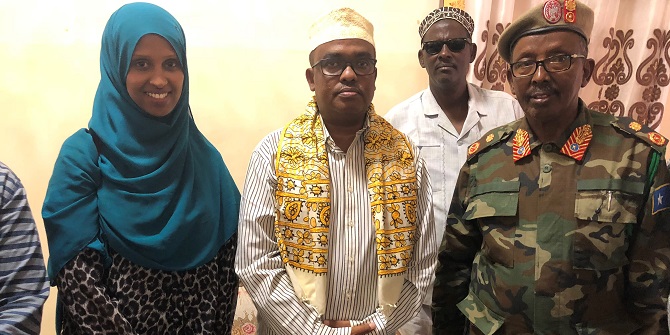
Local agreements are a pervasive feature of contemporary conflict but have been poorly catalogued and mapped. The emphasis has often been placed on documenting national-level agreements. The Conflict Research Programme (CRP) has been developing this theme, considering a number of questions, including what ‘local’ itself means; who do such agreements work for and; how do such agreements relate to core concepts of the CRP, such as the political marketplace, identity politics and civicness. In this light, the CRP- Somalia programme conducted research on the Galkaio conflict and resultant agreement-making process which took place between 2015 and 2017/2018. A policy brief and occasional paper will be released in January/February, 2020, based on this research.
Galkaio town is a border town, with a frontline running through it that represents a border at many levels; between the 20-year old polity of Puntland (now a Federal Member State) and the more volatile central-southern Somalia, between the Darod and Hawiye clan families, as well as between the local clans of the Darod-Mijerteen and Hawiye-Habergedir. Between 2015 and 2017/2018 considerable tensions and episodes of violent conflict broke out, which had national connotations – around the formation of the new Federal structure – as well as local ramifications where an uneasy peace had been maintained for over 20 years.
After two outbreaks of conflict and two ceasefire agreements, the UN Special Representative of the Secretary General’s office (SRSG) and the INGO Interpeace became involved in supporting an agreement process. While there were a number of factors that enabled an ultimately successful agreement to be pursued, this illustration focuses on the individual commitment of a British Somali woman, Ilham Gasser, operating within the SRSG’s office, who was able to leverage the assets of the UN SRSG’s office, while also acting outside the bureaucratic and security constraints (and identity) of the UN itself, and the complementary role played by Interpeace and local partners, who had considerable knowledge, networks and experience in peace-building following a research programme carried out several years previously.
Ilham Gasser and her office recognised that conflict in the border area initially centred around elite levels tensions between the Presidents and wider leadership of the Federal Member States of Puntland and Galmudug and the national President of Somalia. Without an agreement at this level there would be limited possibilities of supporting a local level mediation and agreement-making process. Ilham was able to take advantage of the SRSG’s office to organise a meeting with the three Presidents and cajole a simple written agreement including a visual recording of the agreement, which could be broadcast. Ensuring that this agreement was signed and recorded while all parties were in the same office was essential and held important symbolic value, which then allowed the mediation to move to the local level, in Galkaio town.
In Galkaio town, one of the first initiatives of the SRSG’s office was to organise the NGO community to ensure that the various NGOs followed the same principles, including minimising or stopping per diems being paid for meetings (which frequently provide incentives for the wrong people to attend), and to emphasise that NGOs must facilitate rather than take over, or drive the local discussions and negotiations that would take place through the Joint Ceasefire Committee; practices that too often characterise international engagement.
Ilham was skilled in identifying local factors in the conflict, including who was benefiting financially from the local tensions and who were critical actors locally – political, military, civil society, elders –who, if brought onside or brought together, would greatly improve the chances of success; her interpersonal skills and willingness to ‘go the extra mile’ to understand the drivers of peace and conflict, as well as build trust and relations with different levels of society, from the elite level to local security guards, was crucial – it became a very personal project for her and many others involved.
The relative importance of Ilham to the success of the process is difficult to ascertain and must not be exaggerated, especially where she acted within a wider peace-building network and context, involving many critical actors, but the personal ‘activist’ role resonates with aspects of ‘civicness’ that the CRP is also exploring.
Note: The CRP blogs gives the views of the author, not the position of the Conflict Research Programme, the London School of Economics and Political Science, or the UK Government.




